
Wine Culture and Information since 2002 - Volume 22
 Wine Culture and Information since 2002 - Volume 22 |
|
Issue 101, November 2011 |
Contents |
|
|
2011 is a Great Vintage. No One Can Doubt About This! |
|
We Italians do live in a special Country. Almost magic. At least, according to a viticultural and wine making point of view. It may happen everything in vineyards, a hurricane, torrid and hot summer season, wind sweeping leaves away, snow freezing vines, the quality of grapes is always safe from any adversity. They are always of high quality, getting better and better each passing year. Not even to mention, the prediction of every year gives us the dream of heavenly wines, excellent, of impeccable quality, always rated with the best scores. We are very lucky - we wine lovers - to live in such a special Country capable of not being affected by the course of time and seasons. Every year the large vineyard of our Country is capable of making - everywhere and no matter what, even in the most remote place of the boot - wines of exceptional quality: our vines are bionic, always capable of magnificent performances, mindless of what is going on around them. For example, let's consider 2011. At least in Italy, summer has been extremely torrid, very hot, something not happening since many years. Vintners had many troubles in order to fight the heat that, literally, was burning grapes, at least according to the initial comments from many vintners; some noticed the quantity of harvested grapes would have been lower than past years. Notwithstanding the extraordinary result - a real proud for Italian enology - for having surpassed France in the production of quantity of wine. Of course, we expect the next year everyone will complain for the fact we did not surpass France in this prestigious and fundamental wine making competition, in which the only important aspect is quantity with no consideration for quality. After all, when you do not have anything better, everyone is happy with what you have and with what you can. Of course, I am not saying Italian wine is of poor quality: indeed, quality of Italian wine is very high, with remarkable cases of true excellence. And it is on this aspect we should focus on, not on competitions about quantity. If there are many to talk about a diminishing of grape production - and therefore of wine - there are others who say that, despite of the lower harvested quantity, the quality of grapes is of the highest quality, remarkable and excellent quality. In other words, those who were afraid of not being reassured also in this year, can sleep tight and have sweet dreams: 2011 will give us, once again, exceptional wines of the highest quality. No one has mentioned the fatidic “harvesting of the century” yet, however it is very likely this will happen again for this vintage too. We are so used to that and it is impossible to live without the idea of having ahead of us, on time and reassuring, a vintage of the century. We produced a lower quantity of grape, but what we harvested in our vineyards is of high, very high quality. Who could dare to doubt about this? According to the preliminary data issued by Italian wine makers association, the production of grapes in Italy is lower than 15% in regard of 2010. According to the data issued by Assoenologi (Italian Wine Makers Association), the production of wine expected for 2011 will be of about 40.3 hectoliters, among the lowest in the past 60 years. Despite the high quality of 2011 wines - or at least, they say so - the lowering of production in vineyards is causing some troubles which will not make producers happy nor consumers. The lower harvested quantity has in fact caused a raise of grape prices, a raise that - in some cases - was of about 35%. This raise of prices is not associated to the quality of grapes, indeed by the lower available quantity of raw matter as a consequence of a high demanding. If the raw matter - the grape - has a higher cost, it is likely the final product, the wine, will be sold at higher prices. Saved the case in which producers decide to renounce to part of profits, something that, in these not truly good times according to an economic point of view, represents a remarkable commercial risk. There is no doubt the unusual course of 2011 - which resulted in a relevant anticipation of vine's biological phases - forced producers to make hard choices, in particular for red grapes. Technological ripeness of grapes, that is the one determined by measuring the quantity of sugar and acid contained in the berry, suggested to proceed with harvesting, phenological ripeness, that is the one determining the highest quantity of extractable polyphenols, suggested it was better to wait. It is commonly known, in the process of grape ripening, with time the quantity of sugar tends to increase, while the quantity of acid substances tends to diminish. The decision of harvesting is also determined by this balance: to get the right quantity of sugar without a substantial loss of acidity. In red grapes is also taken in consideration the variable of polyphenols, which must be harvested at the right time and according to technological ripeness. In many cases, in order not to risk a substantial loss of acidity, producers have decided not to wait for phenological ripeness and have started harvesting, in order to have a technological ripe fruit although with a lower quantity of tannins. The risk was, as it can be easily said, the drying of grapes while waiting for phenological ripeness. With this presupposition, red wines - in certain cases - will not be capable of giving their best, saved the cases in which they will correct this during production with proper and legal remedies. Also the climate factor will certainly influence quality, finesse and longevity of wine. And, in this sense, 2003 - which was not a mild vintage - has widely proven, just like other similar years, the effects of a torrid summer season. I have no intention to judge or telling predictions about 2011: I think it would not make much sense to judge what you do not know. My position is always the same, despite the many praiseworthy comments and the unmistakable predictions: I am here and waiting with a glass and a corkscrew at hand. It is the only prediction which really counts. At least to me. Antonello Biancalana
|
||||
Mature Rose WinesWines usually destined to an immediate consumption, rose wines are the expression of freshness of flowers and fruit, however, with time, some of them can also give pleasing surprises |
|
Mature rose wines could be considered a subject of which it would make no sense to talk about. There is in fact a small number of wine lovers who like rose wines, a style produced in a truly marginal quantity if compared to worldwide production, and the few who like them, usually prefer to uncork them within two years from harvesting. Like already said, the production of rose wines is pretty marginal if compared to the other wine styles. The number of producers who make them is pretty small and they usually make few bottles. There are exceptions represented by the wine areas in which these wines are traditionally produced, such as Bardolino, Garda, Trentino, Abruzzo and Salento in Italy o Provence in France. However, rose wine is a style generally consumed in its young age, usually within the year following harvesting. If all consumers prefer to drink rose wines in their youth, does it make any sense to talk about mature rose wines? Indeed, among all wine styles, these are the least suited to stand to a long period of time of aging in cask. There however are exceptions to this and all depends on how the wine was made, from grapes to vinification techniques. In this regard, rose wines are not so different from any other style of wine. Just like most of white wines, roses are produced in order to be consumed in their youth, therefore to allow the appreciation of their fresh and immediate characters, however, just like some whites, there are some exceptions. These exceptions, although they are even more uncommon than in whites, can however give pleasing sensations as time goes by. In these cases, crisp and immediate sensations are however replaced by complex organoleptic qualities, not always being appreciated. The specific techniques used for the production of rose wines strongly affect their possibilities of aging with time. There are techniques suited for the production of rose wines destined to an immediate consumption - that is, most of them - whereas others allow to these wines to be kept and to develop for some years in bottle. Also the variety of grapes used for production is directly responsible of the aging possibilities in roses and, however, they are red berried grapes properly vinified. It should also be said not all the techniques used for the production of rose wines have the goal of producing this specific style of wine. Some rose wines, in fact, are the result of a byproduct of the production of red wines, a technique - we will talk about this later - allowing the enrichment of body, structure and concentration in red wines, by using part of the must for the production of rose wines.
Rose wines are usually produced by making use of four techniques, three of them being very similar one to each other, the fourth one - like already said - is to be considered as a byproduct of some red wine production. The principle with which it is based the production of rose wines is however the same in all the cases: to make a wine from red berried grapes with a variable pink color by means of a short maceration of the must with the skins. This result can be obtained by changing one of the main factors determining the color of rose wines: time. As it is commonly known, grape juice of most of varieties, including red ones, is white, with a characteristic green-gray color. Grape juice - the must - gets a red color thanks to the contact with the skin of red varieties, the part of the berry in which are found coloring substances. Therefore, after having crushed grapes, if we immediately separate skins from the must, we get a white must and with no color, therefore suited for the production of white wines. The time factor is therefore fundamental for the production of rose wines and their color. The longer the must is being macerated with the skins, the more the color will become red. If for a red wine the maceration can also last many days, in some cases for more than one month, for rose wines this time is always measured in hours. Six, twelve, twenty-four hours: it is very rare to go beyond and for a longer time. In other words, a quantity of time in order to allow the must to get a pink color. The duration of maceration in rose wines depends on many factors, including the coloring capacity of the grape - grapes with a high quantity of coloring substances need few hours - and the type of wine to be produced. To summarize things up, everything starts from the crushing of red grapes, the must is allowed to macerate with the skins for some hours, therefore the must is separated from the skins and the process ends with the classic vinification in in white. During the maceration it can also start fermentation, a condition helping - as it is commonly known - the extraction of the color from the skins. According to the duration of maceration, rose wines are defined in vin gris (gray wines), roses produced with a maceration of few hours; wines of one night, roses produced with a variable maceration from 8 to 12 hours; wines of one day, roses produced with a maceration from 12 and 24 hours. Rose wines are hardly macerated with the skins for times longer than 24 hours, however it should be noticed that for some rose wine - produced in order to get particular results - the duration can also be of 48 hours. The maceration with the skins does not only give color. As it is usually known, the skin of grapes also contains aromatic and polyphenolic substances, both passed to the must during the maceration. These two groups of substances will respectively contribute to the enrichment of the olfactory profile of the wine and to its structure. Besides the techniques expressly used for the production of rose wines, there is also another one which can be considered as a byproduct of the vinification of red wines. This particular technique is usually called with the French name saignée, usually translated as “bleeding”. The principle of bleeding is to give more body to a red wine by concentrating the must, by diminishing the ratio between the quantity of skins - that is, polyphenols and color - and the must. The procedure consists in drawing a quantity of must off from the fermentation tank after few hours, or few days, and as the must has undergone a short maceration with the skins, its color has turned into pink. This part of must is then fermented and vinified in white, therefore obtaining, at the end of the procedure, a rose wine. As a matter of fact, both bleeding and the other techniques, are all based on the same principle, that is obtaining a must, shortly macerated with the skins, in order to extract a small quantity of coloring substances according to the pink color the producer wishes to get. The duration of maceration is not only decided according to the color the producer wishes to obtain. During the maceration, from the skins is not only extracted color, but also other polyphenolic substances - commonly called tannins - and which will contribute to the structure of wine. Just like any other style of wine, also rose wines are produced according to a specific style, last but not the least, the type of market, therefore consumption, to which they are destined to. In general terms, rose wines are produced with the specific goal of being consumed within few months or a little more than one year from their production: they are hardly produced with the goal of allowing them a good aging in bottle. This choice is also determined by the way consumers consider rose wines: wines expressing a fresh and immediate quality, in which must be perceived aromas of flowers and fruits. If young rose wines are among the least sold and appreciated ones, mature roses wines are even less. What allows rose wines to properly evolve in bottle, while developing, with time, complex organoleptic qualities and, at the same time, appreciable characteristics without compromising agreeability? Factors allowing a proper aging of every wine are always the same and rose wines are no exception. Acidity, alcohol, presence of polyphenolic substances and - according to the style - sugar, are the substances which can ensure rose wines a proper evolution in bottle. Like already said, rose wines are produced with red berried grapes - while noticing, at least in Italy, it is not permitted the production of roses by adding white grapes, with the exception of sparkling wines - varieties of grapes not particularly rich is acid substances. With the exception of few cases, such as Nebbiolo, Pinot Noir and Aglianico, acidity in red berried grapes is lower than white varieties. As a consequence of this, acidity in rose wines will not significantly contribute to their keeping. This does not mean rose wines do not have the crispness expressed by acidity; indeed, this organoleptic sensation is a specific characteristic of this wine style. It is not by chance rose wines are considered an “in between” - although representing a category on their own - with whites and reds. In fact, of white wines they have freshness and acidity, of reds they have aromas and, in some cases, a structure which can be compared to certain young and light red wines. A sure fact about rose wines is they do not have the same freshness of whites, referred to acidity. To the keeping of rose wines - in part influenced by acidity - significantly contributes alcohol, and this widely depends by the type of grape and its ripeness, as well as polyphenolic substances extracted during the short maceration. Also the quantity of polyphenolic substances passed to the must during the maceration widely depends on the type of grape. Rose wines suited for the aging in bottle greatly benefit of the presence of polyphenols. When tannins are present in modest quantity, a characteristic common to most of rose wines destined to an immediate consumption, the wine is usually helped with the aging - and sometimes, the fermentation - in cask. This particular wine making procedure enriches, as a matter of fact, the wine of polyphenolic substances that, besides making the wine more robust, allow the rose wine to better walk the long march of time when it will be bottled. Rose wines aged in wood, a category made by a very small number of examples, are the ones to be suited for the aging in bottle. Even better, rose wines with an alcohol by volume greater than the average value for this style, usually 12-13%, is a quality substantially helping the possibilities of evolution with time. Rose wines not suited to the aging in bottle are therefore the ones expressly produced for an immediate consumption, produced in order to emphasize qualities of crispness and freshness, just like white wines destined to the same type of market. With times, and as it can be easily said, rose wines lose their characteristic of freshness as well as their fruit aromas, while acquiring, with time, a rounder personality, with aromas and tastes resembling jams and, sometimes, dried fruits, such as hazelnut. Also color will turn into a pale orange hue, something also happening in very mature red wines. The typical acidity in rose wines is strongly attenuated, something which can also be perceived in white wines. The tasting of mature rose wines can sometimes be confusing, because of the development giving, like to say, an unusual organoleptic quality. A rose wine having the right characteristics suited for the aging in bottle is however a wine which does not pass unnoticed, a wine having a strong personality, so distant from the sensations offered by a white or a red. And this is not a fault, indeed, it is just another possibility for better appreciating rose wines.
|
||||||||||||
Wines of the Month |
|
|
|
Score legend Prices are to be considered as indicative. Prices may vary according to the country or the shop where wines are bought |
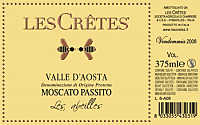
|
|
Valle d'Aosta Moscato Passito Les Abeilles 2008 |
|
| Les Crêtes (Vallée d'Aoste, Italy) | |
| Grapes: Muscat Blanc | |
| Price: € 22.00 - 375ml | Score: |
| Valle d'Aosta Moscato Passito Les Abeilles shows a pale amber yellow and nuances of golden yellow, very transparent. The nose denotes intense, clean, pleasing, refined and elegant aromas which start with hints of raisin, fig jam and dried apricot followed by aromas of quince jam, ripe banana, caramel, honey, date, peach jam, hazelnut and nail polish. The mouth has good correspondence to the nose, a sweet and round attack, however balanced by alcohol, good body, intense flavors, pleasing crispness. The finish is persistent with flavors of raisin, fig jam and dried apricot. Valle d'Aosta Moscato Passito Les Abeilles ages in steel tanks and is produced with late harvested grapes. | |
| Food Match: Dried fruit tarts, Confectionery, Hard cheese | |
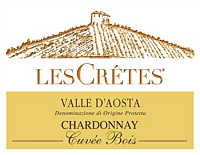
|
|
Valle d'Aosta Chardonnay Cuvée Bois 2008 |
|
| Les Crêtes (Vallée d'Aoste, Italy) | |
| Grapes: Chardonnay | |
| Price: € 34.00 | Score: |
| Valle d'Aosta Chardonnay Cuvée Bois shows an intense golden yellow color and nuances of golden yellow, very transparent. The nose reveals intense, clean, pleasing, refined and elegant aromas that start with hints of banana, hazelnut and plum followed by aromas of apple, acacia, pear, grapefruit, vanilla, citrus fruit peel, butter, praline and mineral. The mouth has good correspondence to the nose, a crisp attack and however balanced by alcohol, full body, intense flavors, pleasing roundness. The finish is very persistent with long flavors of banana, plum and hazelnut. Valle d'Aosta Chardonnay Cuvée Bois ages for 10 months in cask followed by 8 months of aging in bottle. | |
| Food Match: Pasta with meat, Roasted white meat, Roasted fish | |

|
|
Montecucco Rosso Riserva Orto di Boccio 2006 |
|
| Villa Patrizia (Tuscany, Italy) | |
| Grapes: Sangiovese (70%), Merlot (20%), Cabernet Sauvignon (10%) | |
| Price: € 18.00 | Score: |
| Montecucco Rosso Riserva Orto di Boccio shows an intense ruby red color and nuances of garnet red, little transparency. The nose reveals intense, clean, pleasing and refined aromas which start with hints of plum, black cherry and black currant followed by aromas of blueberry, violet, vanilla, tobacco, chocolate, mace and pink pepper. The mouth has good correspondence to the nose, a tannic attack and however balanced by alcohol, good body, intense flavors, agreeable. The finish is persistent with flavors of plum, black cherry and black currant. Montecucco Rosso Riserva Orto di Boccio ages for 24 months in barrique. | |
| Food Match: Roasted meat, Stewed and braised meat with mushrooms, Hard cheese | |

|
|
Morellino di Scansano Riserva Le Valentane 2007 |
|
| Villa Patrizia (Tuscany, Italy) | |
| Grapes: Sangiovese | |
| Price: € 20.00 | Score: |
| Morellino di Scansano Riserva Le Valentane shows an intense ruby red color and nuances of garnet red, moderate transparency. The nose denotes intense, clean, pleasing and refined aromas that start with hints of plum, black cherry and dried violet followed by aromas of blackberry, blueberry, vanilla, tobacco, chocolate, cinnamon, mace and graphite. The mouth has good correspondence to the nose, a tannic attack and however balanced by alcohol, good body, intense flavors, pleasing roundness. The finish is persistent with flavors of plum, black cherry and blackberry. Morellino di Scansano Riserva Le Valentane ages for 24 months in barrique followed by 12 months of aging in bottle. | |
| Food Match: Roasted meat, Stewed and braised meat, Broiled meat and barbecue, Hard cheese | |
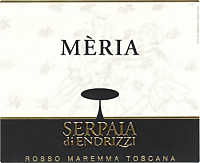
|
|
Mèria 2007 |
|
| Serpaia (Tuscany, Italy) | |
| Grapes: Merlot, Cabernet Sauvignon, Sangiovese, Petit Verdot | |
| Price: € 13.50 | Score: |
| Mèria shows a brilliant ruby red color and nuances of garnet red, moderate transparency. The nose denotes intense, clean, pleasing and refined aromas that start with hints of black cherry, plum and blackberry followed by aromas of blueberry, black currant, violet, tobacco, mace, chocolate and vanilla. The mouth has good correspondence to the nose, a slightly tannic attack and however balanced by alcohol, good body, intense flavors, pleasing roundness. The finish is persistent with flavors of black cherry, plum and blackberry. Mèria ages for 12 months in barrique, 6 months in cask and for 6 months in bottle. | |
| Food Match: Stewed meat with mushrooms, Broiled meat and barbecue, Hard cheese | |
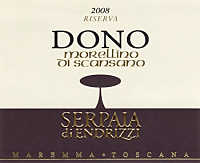
|
|
Morellino di Scansano Riserva Dono 2008 |
|
| Serpaia (Tuscany, Italy) | |
| Grapes: Sangiovese | |
| Price: € 13.50 | Score: |
| Morellino di Scansano Riserva Dono shows a brilliant ruby red color and nuances of garnet red, moderate transparency. The nose denotes intense, clean, pleasing and refined aromas which start with hints of plum, black cherry and dried violet followed by aromas of blueberry, chocolate, vanilla, tobacco, cinnamon, mace and menthol. The mouth has good correspondence to the nose, a tannic attack and however balanced by alcohol, good body, intense flavors, agreeable. The finish is persistent with flavors of plum, black cherry and blueberry. Morellino di Scansano Riserva Dono ages for 12 months in barrique followed by 8 months of aging in bottle. | |
| Food Match: Roasted meat, Broiled meat and barbecue, Stewed meat with mushrooms, Hard cheese | |
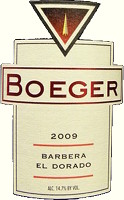
|
|
Barbera El Dorado 2008 |
|
| Boeger (California, United States of America) | |
| Grapes: Barbera | |
| Price: $ 17.00 | Score: |
| Barbera El Dorado shows a brilliant ruby red color and nuances of garnet red, moderate transparency. The nose denotes intense, clean, pleasing and refined aromas that start with hints of cherry, plum and raspberry followed by aromas of vanilla, cocoa, pink pepper and menthol. The mouth has good correspondence to the nose, a slightly tannic attack, pleasing crispness and however balanced by alcohol, good body, intense flavors, pleasing roundness. The finish is persistent with flavors of cherry, plum and raspberry. Barbera El Dorado ages for 17 months in cask. | |
| Food Match: Broiled meat and barbecue, Stuffed pasta, Stewed meat with mushrooms | |
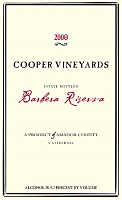
|
|
Barbera 2008 |
|
| Cooper Vineyards (California, United States of America) | |
| Grapes: Barbera | |
| Price: $ 32.00 | Score: |
| This Barbera shows a brilliant ruby red color and nuances of garnet red, moderate transparency. The nose denotes intense, clean, pleasing and refined aromas which start with hints of cherry, raspberry and plum followed by aromas of vanilla, violet, tobacco, tamarind, cocoa and pink pepper. The mouth has good correspondence to the nose, a slightly tannic attack and however balanced by alcohol, good body, intense flavors, pleasing crispness. The finish is persistent with flavors of cherry, plum and raspberry. This Barbera ages in cask. | |
| Food Match: Stuffed pasta, Sauteed meat, Stewed meat with mushrooms | |
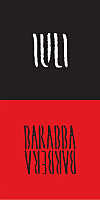
|
|
Barbera del Monferrato Superiore Barabba 2006 |
|
| Iuli (Piedmont, Italy) | |
| Grapes: Barbera | |
| Price: € 30.00 | Score: |
| Barbera del Monferrato Superiore Barabba shows a brilliant ruby red color and nuances of ruby red, little transparency. The nose denotes intense, clean, pleasing, refined and elegant aromas which start with hints of cherry, plum and violet followed by aromas of blackberry, blueberry, vanilla, tobacco, pink pepper, cocoa, mace, cinnamon and menthol. The mouth has good correspondence to the nose, a slightly tannic attack and pleasing crispness, however balanced by alcohol, good body, intense flavors, agreeable. The finish is persistent with flavors of cherry, plum and blackberry. Barbera del Monferrato Superiore Barabba ages for 28 months in barrique followed by 6 months of aging in bottle. | |
| Food Match: Roasted meat, Braised and stewed meat with mushrooms, Hard cheese | |
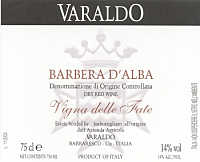
|
|
Barbera d'Alba Vigna delle Fate 2005 |
|
| Varaldo (Piedmont, Italy) | |
| Grapes: Barbera | |
| Price: € 16.00 | Score: |
| Barbera d'Alba Vigna delle Fate shows an intense ruby red color and nuances of garnet red, little transparency. The nose denotes intense, clean, pleasing and refined aromas that start with hints of cherry jam, plum and dried violet followed by aromas of blackberry, vanilla, tobacco, pink pepper, chocolate, mace and menthol. The mouth has good correspondence to the nose, a tannic attack and however balanced by alcohol, good body, intense flavors, pleasing crispness. The finish is persistent with flavors of cherry jam, plum and blackberry. Barbera d'Alba Vigna delle Fate ages for 18 months in barrique followed by 6 months of aging in bottle. | |
| Food Match: Roasted meat, Stewed and braised meat with mushrooms, Hard cheese | |
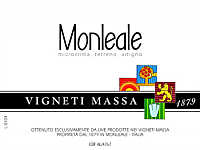
|
|
Colli Tortonesi Barbera Monleale 2006 |
|
| Vigneti Massa (Piedmont, Italy) | |
| Grapes: Barbera | |
| Price: € 15.00 | Score: |
| Colli Tortonesi Barbera Monleale shows a brilliant ruby red color and nuances of garnet red, moderate transparency. The nose reveals intense, clean, pleasing and refined aromas that start with hints of cherry, plum and violet followed by aromas of blueberry, vanilla, tobacco, mace, chocolate and menthol. The mouth has good correspondence to the nose, a slightly tannic attack and however balanced by alcohol, good body, intense flavors, pleasing crispness. The finish is persistent with flavors of cherry, plum and blueberry. Colli Tortonesi Barbera Monleale ages for 22 months in barrique. | |
| Food Match: Stewed meat with mushrooms, Roasted meat, Broiled meat and barbecue | |
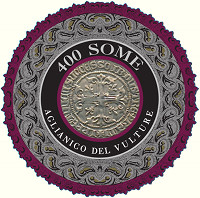
|
|
Aglianico del Vulture 400 Some 2007 |
|
| Carbone Vini (Basilicata, Italy) | |
| Grapes: Aglianico | |
| Price: € 14.50 | Score: |
| Aglianico del Vulture 400 Some shows an intense ruby red color and nuances of garnet red, little transparency. The nose reveals intense, clean, pleasing, refined and elegant aromas that start with hints of blackberry, plum and black cherry followed by aromas of dried violet, blueberry, tobacco, vanilla, chocolate, mace and menthol. The mouth has good correspondence to the nose, a tannic attack and however balanced by alcohol, full body, intense flavors, pleasing roundness. The finish is persistent with flavors of plum, blackberry and black cherry. Aglianico del Vulture 400 Some ages in barrique. | |
| Food Match: Game, Roasted meat, Braised and stewed meat, Hard cheese | |
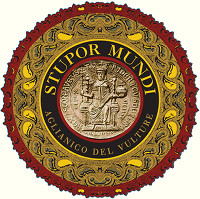
|
|
Aglianico del Vulture Stupor Mundi 2007 |
|
| Carbone Vini (Basilicata, Italy) | |
| Grapes: Aglianico | |
| Price: € 21.00 | Score: |
| Aglianico del Vulture Stupor Mundi shows an intense ruby red color and nuances of garnet red, little transparency. The nose reveals intense, clean, pleasing, refined and elegant aromas which start with hints of plum, blackberry and black cherry followed by aromas of dried violet, blueberry, vanilla, chocolate, clover, leather, licorice, tobacco, mace and menthol. The mouth has excellent correspondence to the nose, a tannic attack and however balanced by alcohol, full body, intense flavors, pleasing roundness. The finish is very persistent with long flavors of blackberry, plum and black cherry. Aglianico del Vulture Stupor Mundi ages for 12 months in cask followed by 12 months of aging in bottle. | |
| Food Match: Game, Roasted meat, Braised and stewed meat, Hard cheese | |
News |
|
In this section are published news and information about events concerning the world of wine and food. Whoever is interested in publishing this kind of information can send us a mail to our address.
|
AquavitaeReview of Grappa, Distillates and Brandy |
|
|
| Distillates are rated according to DiWineTaste's evaluation method. Please see score legend in the "Wines of the Month" section. |
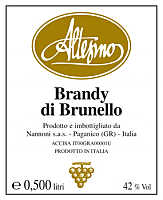
|
|
Brandy di Brunello |
|
| Altesino (Tuscany, Italy) | |
| (Distiller: Distilleria Nannoni) | |
| Raw matter: Brunello di Montalcino | |
| Price: € 25.00 - 50cl | Score: |
| This brandy shows a pale amber yellow color and nuances of golden yellow, very transparent. The nose reveals intense, clean and refined aromas of chocolate, hazelnut, prune, dried violet, vanilla and honey, with almost imperceptible alcohol pungency. In the mouth has intense flavors with perceptible alcohol pungency which tends to dissolve rapidly, good correspondence to the nose, pleasing roundness, balanced. The finish is persistent with flavors of chocolate, prune and honey. This brandy is produced with Brunello di Montalcino distilled in discontinuous steam operated alembic still and aged in casks of different woods. Alcohol 42%. | |
Wine Parade |
|
|
| The best 15 wines according to DiWineTaste's readers. To express your best three wines send us an E-mail or fill in the form available at our WEB site. |
| Rank | Wine, Producer | |
|---|---|---|
| 1 |
| Arkezia Muffo di San Sisto 2004, Fazi Battaglia (Italy) |
| 2 |
| Brunello di Montalcino Vigneto Manachiara 2005, Tenute Silvio Nardi (Italy) |
| 3 |
| Confini 2007, Lis Neris (Italy) |
| 4 |
| Barolo Cannubi Boschis 2005, Sandrone (Italy) |
| 5 |
| Trento Brut Riserva Methius 2004, Dorigati (Italy) |
| 6 |
| Rosso Conero Riserva Grosso Agontano 2007, Garofoli (Italy) |
| 7 |
| Aglianico del Vulture Il Repertorio 2006, Cantine del Notaio (Italy) |
| 8 |
| Brunello di Montalcino 2006, Siro Pacenti (Italy) |
| 9 |
| Soave Motto Piane 2008, Fattori (Italy) |
| 10 |
| Batàr 2008, Querciabella (Italy) |
| 11 |
| Brunello di Montalcino Progetto Prime Donne 2004, Donatella Cinelli Colombini (Italy) |
| 12 |
| Collio Sauvignon Ronco delle Mele 2010, Venica (Italy) |
| 13 |
| Barolo Bussia 2001, Prunotto (Italy) |
| 14 |
| Gran Masetto 2007, Endrizzi (Italy) |
| 15 |
| Chianti Classico Riserva 2005, Capannelle (Italy) |
| |||||||
Privacy Policy | |||||||


| Copyright © 2002-2024 Antonello Biancalana, DiWineTaste - All rights reserved |
| All rights reserved under international copyright conventions. No part of this publication and of this WEB site may be
reproduced or utilized in any form or by any means, electronic or mechanical, without permission in writing from DiWineTaste. |